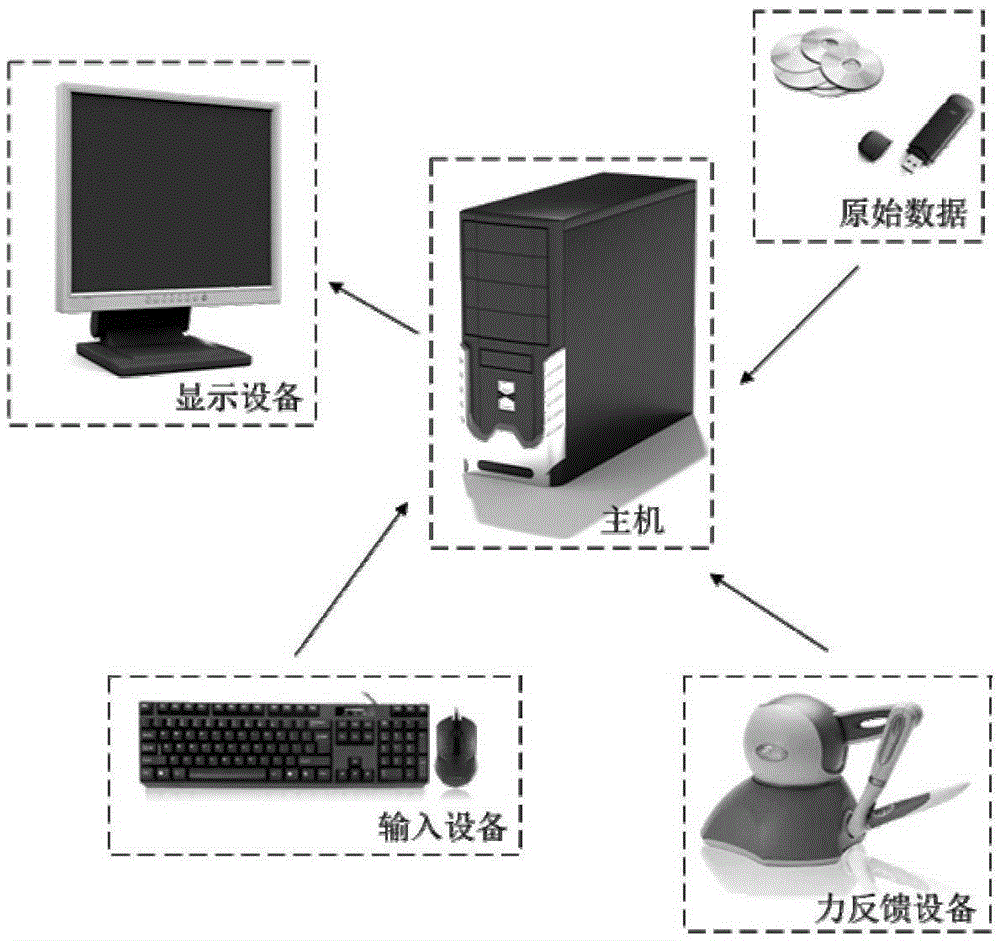Orthopedic surgery operation simulation system on the basis of force feedback
A technology of orthopedic surgery and surgical simulation, applied in the field of virtual surgery system development, can solve the problems of high cost and complexity
- Summary
- Abstract
- Description
- Claims
- Application Information
AI Technical Summary
Problems solved by technology
Method used
Image
Examples
specific Embodiment approach 1
[0092] Specific implementation mode one: as figure 1 and 2 As shown, a force feedback-based orthopedic surgery simulation system in this embodiment includes: a virtual orthopedic surgery simulation subsystem 1 , an input module 2 , a force feedback device 3 , and a display device 4 .
[0093]The virtual orthopedic surgery simulation subsystem 1 is used to realize the geometric modeling of human tissue, mesh division, biomechanical modeling and calculation, collision detection, cutting and suturing and dynamic visualization, and force feedback calculation of human tissue required in the surgical simulation process; The orthopedic surgery simulation subsystem 1 is also used to receive and process the two-dimensional tomographic image information of the patient imported in the input module 2; the virtual orthopedic surgery simulation subsystem 1 is also used to calculate the feedback force required by the force feedback device 3, that is, the human body Force feedback to simulat...
specific Embodiment approach 2
[0111] In this embodiment, the specific process of the virtual orthopedic surgery simulation subsystem 1 realizing its functions is as follows:
[0112] 1) Geometric modeling module
[0113] The geometric modeling module can choose VTK, MITK and other tools for development. Such as image 3 As shown, the process of geometric modeling involves steps such as threshold screening, interactive segmentation, and 3D reconstruction. The process of threshold screening adopts the threshold segmentation algorithm to initially segment the patient's bone, cartilage, muscle, fat, skin and other tissues. The interactive segmentation process uses the variable filling algorithm of polygons. Users can combine anatomical knowledge and experience to manually erase and repair each picture to improve the quality and speed of image segmentation. The process of 3D reconstruction of the model can use the currently popular MarchingCube algorithm or DividingCube algorithm to generate a 3D surface mod...
specific Embodiment approach 3
[0163] In the present embodiment, the concrete process that described input module 2 realizes its function is:
[0164] 1) Image data input unit
[0165] CT / MRI images can be transmitted through the optical drive or USB interface of the main computer box, and then imported into the virtual orthopedic surgery simulation subsystem to prepare for geometric modeling.
[0166] 2) User operation unit
[0167] The realization of this unit can be completed by developing an operation interface of a virtual orthopedic surgery simulation subsystem under the MFC platform. On the operation interface, the user inputs operation-related information through computer input devices such as keyboards and mice. The operation-related information may include the patient’s name, gender, age, case, etc. The operation-related information may also include operation steps, operation-related precautions, examination Users can also switch the viewing angle, size, transparency, etc. of the virtual human t...
PUM
 Login to View More
Login to View More Abstract
Description
Claims
Application Information
 Login to View More
Login to View More - R&D
- Intellectual Property
- Life Sciences
- Materials
- Tech Scout
- Unparalleled Data Quality
- Higher Quality Content
- 60% Fewer Hallucinations
Browse by: Latest US Patents, China's latest patents, Technical Efficacy Thesaurus, Application Domain, Technology Topic, Popular Technical Reports.
© 2025 PatSnap. All rights reserved.Legal|Privacy policy|Modern Slavery Act Transparency Statement|Sitemap|About US| Contact US: help@patsnap.com



